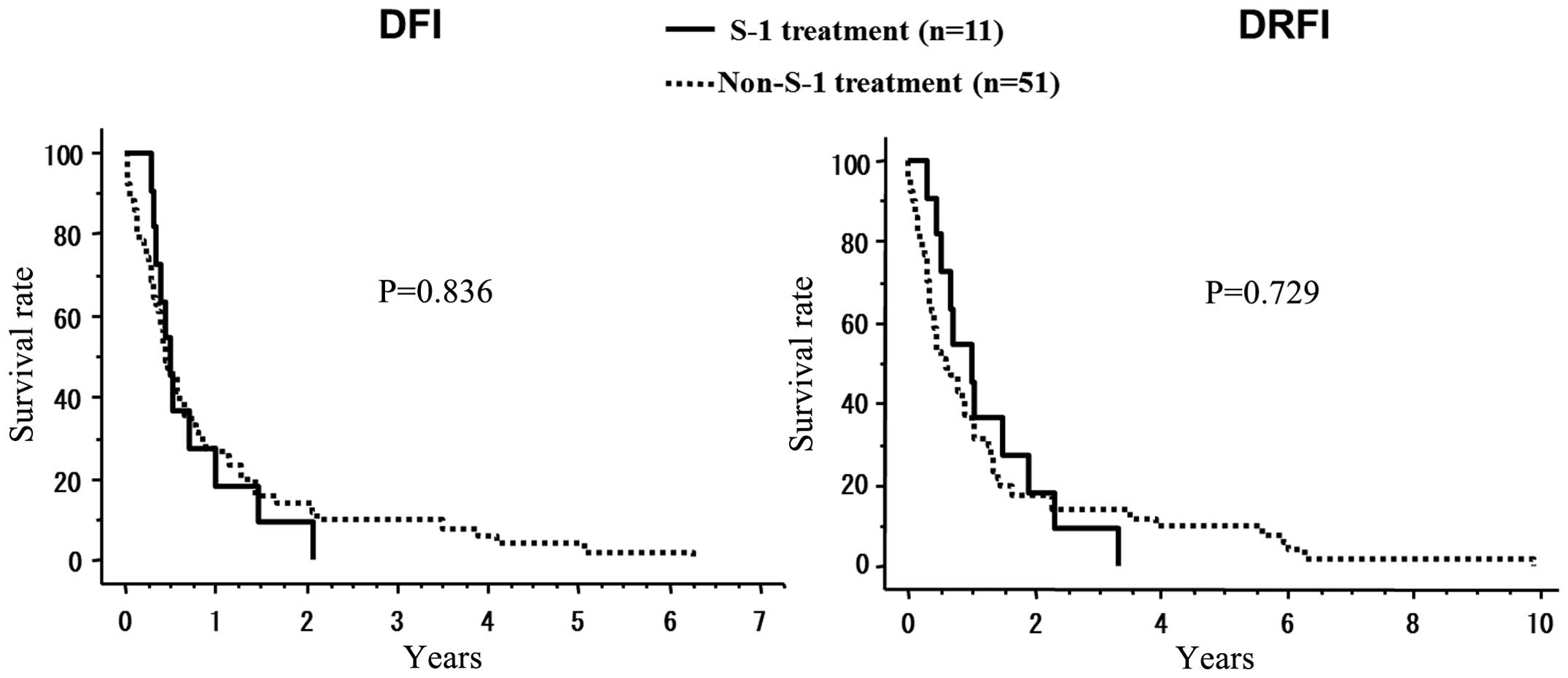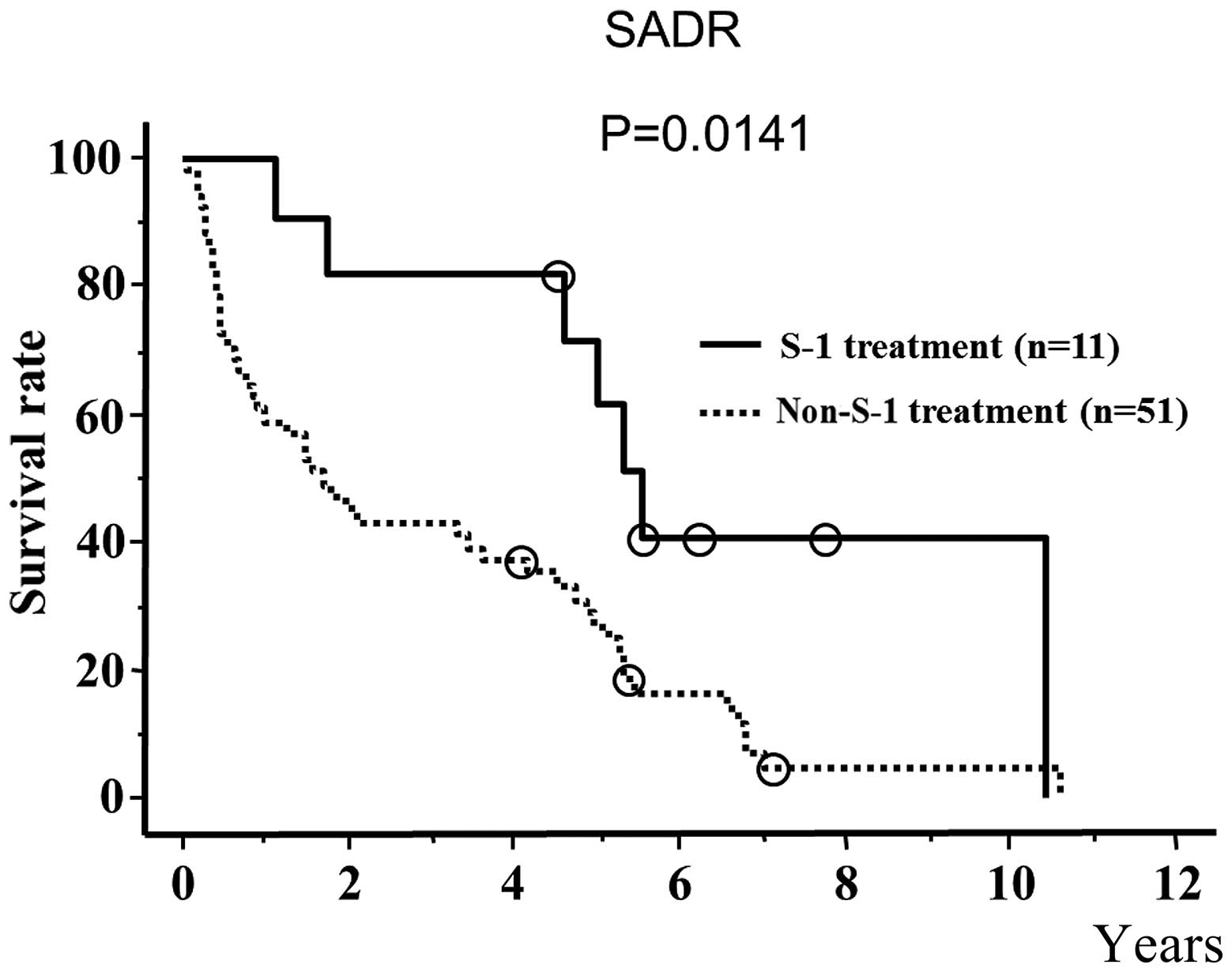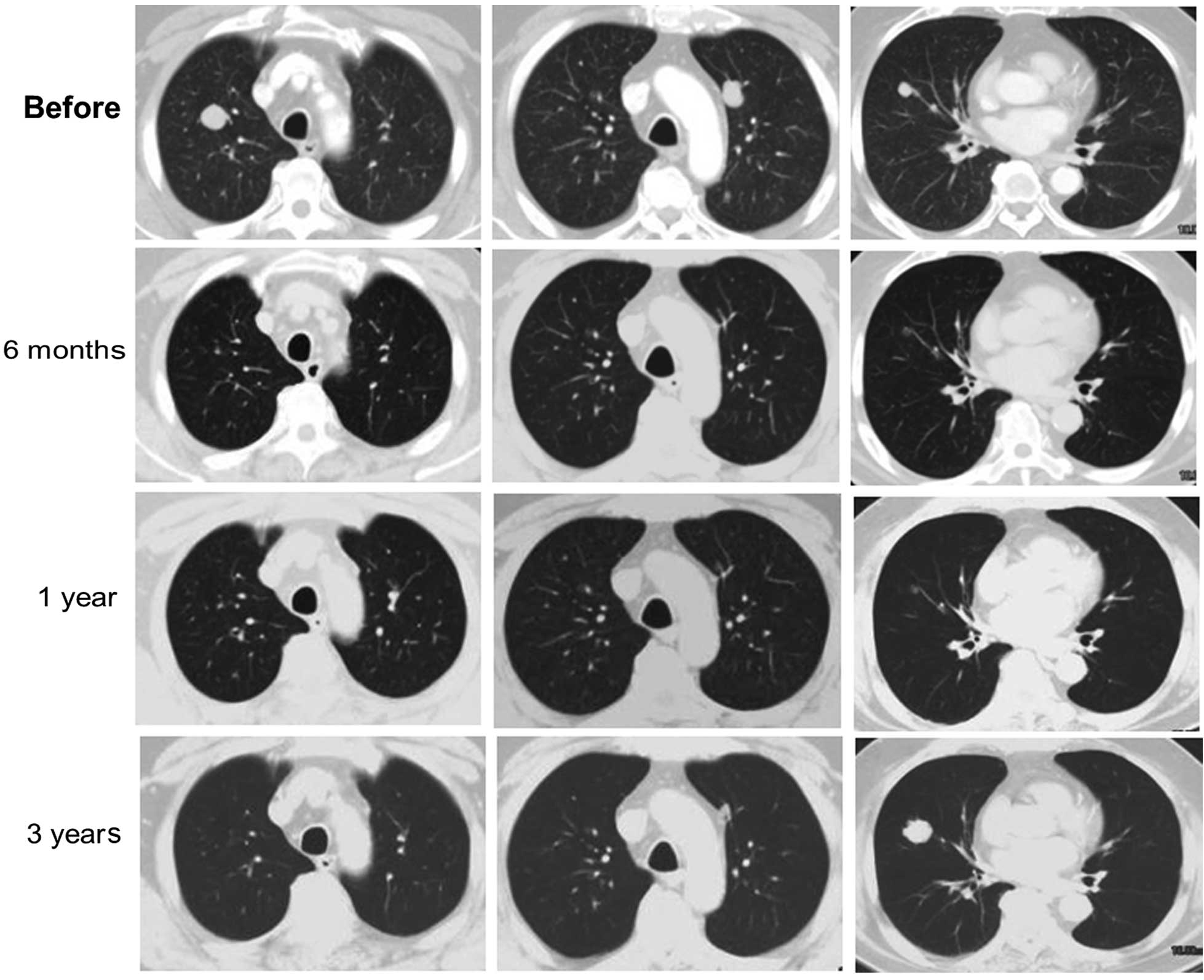|
1
|
Kamangar F, Dores GM and Erson WF:
Patterns of cancer incidence, mortality and prevalence across five
continents: defining priorities to reduce cancer disparities in
different geographic regions of the world. J Clin Oncol.
24:2137–2150. 2006. View Article : Google Scholar : PubMed/NCBI
|
|
2
|
Parkin DM, Bray F, Ferlay J, et al: Global
cancer statistics, 2002. CA Cancer J Clin. 55:74–108. 2005.
View Article : Google Scholar : PubMed/NCBI
|
|
3
|
Minagawa M, Makuuchi M, Takayama T, et al:
Selection criteria for repeat hepatectomy in patients with
recurrent hepatocellular carcinoma. Ann Surg. 238:703–710. 2003.
View Article : Google Scholar : PubMed/NCBI
|
|
4
|
Poon RT, Fan ST, Lo CM, et al:
Intrahepatic recurrence after curative resection of hepatocellular
carcinoma: long-term results of treatment and prognostic factors.
Ann Surg. 229:216–222. 1999. View Article : Google Scholar : PubMed/NCBI
|
|
5
|
Yamasaki T, Kurokawa F, Shirahashi H, et
al: Percutaneous radiofrequency ablation therapy with combined
angiography and computed tomography assistance for patients with
hepatocellular carcinoma. Cancer. 91:1342–1348. 2001. View Article : Google Scholar : PubMed/NCBI
|
|
6
|
Yang Y, Nagano H, Ota H, et al: Patterns
and clinicopathologic features of extrahepatic recurrence of
hepatocellular carcinoma after curative resection. Surgery.
141:196–202. 2007. View Article : Google Scholar : PubMed/NCBI
|
|
7
|
Shimada M, Takenaka K, Gion T, et al:
Prognosis of recurrent hepatocellular carcinoma: a 10-year surgical
experience in Japan. Gastroenterology. 111:720–726. 1996.
View Article : Google Scholar : PubMed/NCBI
|
|
8
|
Llovet JM, Ricci S, Mazzaferro V, et al:
Sorafenib in advanced hepatocellular carcinoma. N Engl J Med.
359:378–390. 2008. View Article : Google Scholar : PubMed/NCBI
|
|
9
|
Yau T, Chan P, Ng KK, et al: Phase 2
open-label study of single-agent sorafenib in treating advanced
hepatocellular carcinoma in a hepatitis B-endemic Asian population:
presence of lung metastasis predicts poor response. Cancer.
115:428–436. 2009. View Article : Google Scholar : PubMed/NCBI
|
|
10
|
Lam CM, Lo CM, Yuen WK, et al: Prolonged
survival in selected patients following surgical resection for
pulmonary metastasis from hepatocellular carcinoma. Br J Surg.
85:1198–1200. 1998. View Article : Google Scholar : PubMed/NCBI
|
|
11
|
Kwon JB, Park K, Kim YD, et al: Clinical
outcome after pulmonary metastasectomy from primary hepatocellular
carcinoma: analysis of prognostic factors. World J Gastroenterol.
14:5717–5722. 2008. View Article : Google Scholar : PubMed/NCBI
|
|
12
|
Sakon M, Nagano H, Dono K, et al: Combined
intraarterial 5-fluorouracil and subcutaneous interferon-alpha
therapy for advanced hepatocellular carcinoma with tumor thrombi in
the major portal branches. Cancer. 94:435–442. 2002. View Article : Google Scholar : PubMed/NCBI
|
|
13
|
Nagano H, Miyamoto A, Wada H, et al:
Interferon-alpha and 5-fluorouracil combination therapy after
palliative hepatic resection in patients with advanced
hepatocellular carcinoma, portal venous tumor thrombus in the major
trunk and multiple nodules. Cancer. 110:2493–2501. 2007. View Article : Google Scholar : PubMed/NCBI
|
|
14
|
Nakamura M, Nagano H, Marubashi S, et al:
Pilot study of combination chemotherapy of S-1, a novel oral DPD
inhibitor and interferon-alpha for advanced hepatocellular
carcinoma with extrahepatic metastasis. Cancer. 112:1765–1771.
2008. View Article : Google Scholar : PubMed/NCBI
|
|
15
|
Shirasaka T, Nakano K, Takechi T, et al:
Antitumor activity of 1 M tegafur-0.4 M
5-chloro-2,4-dihydroxypyridine-1 M potassium oxonate (S-1) against
human colon carcinoma orthotopically implanted into nude rats.
Cancer Res. 56:2602–2606. 1996.PubMed/NCBI
|
|
16
|
Takechi T, Nakano K, Uchida J, et al:
Antitumor activity and low intestinal toxicity of S-1, a new
formulation of oral tegafur, in experimental tumor models in rats.
Cancer Chemother Pharmacol. 39:205–211. 1997. View Article : Google Scholar : PubMed/NCBI
|
|
17
|
Yoshisue K, Hironaga K, Yamaguchi S, et
al: Reduction of 5-fluorouracil (5-FU) gastrointestinal (GI)
toxicity resulting from the protection of thymidylate synthase (TS)
in GI tissue by repeated simultaneous administration of potassium
oxonate (Oxo) in rats. Cancer Chemother Pharmacol. 46:51–56. 2000.
View Article : Google Scholar : PubMed/NCBI
|
|
18
|
Nakata B, Mitachi Y, Tsuji A, et al:
Combination phase I trial of a novel oral fluorouracil derivative
S-1 with low-dose cisplatin for unresectable and recurrent gastric
cancer (JFMC27-9902). Clin Cancer Res. 10:1664–1669. 2004.
View Article : Google Scholar : PubMed/NCBI
|
|
19
|
Ueno H, Okusaka T, Ikeda M, et al: An
early phase II study of S-1 in patients with metastatic pancreatic
cancer. Oncology. 68:171–178. 2005. View Article : Google Scholar : PubMed/NCBI
|
|
20
|
Katyal S, Oliver JH III, Peterson MS, et
al: Extrahepatic metastases of hepatocellular carcinoma. Radiology.
216:698–703. 2000. View Article : Google Scholar : PubMed/NCBI
|
|
21
|
Ikai I, Arii S, Kojiro M, et al:
Reevaluation of prognostic factors for survival after liver
resection in patients with hepatocellular carcinoma in a Japanese
nationwide survey. Cancer. 101:796–802. 2004. View Article : Google Scholar : PubMed/NCBI
|
|
22
|
Tomimaru Y, Sasaki Y, Tamada T, et al: The
significance of surgical resection for pulmonary metastasis from
hepatocellular carcinoma. Am J Surg. 192:46–51. 2006. View Article : Google Scholar : PubMed/NCBI
|
|
23
|
Kawamura M, Nakajima J, Matsuguma H, et al
Metastatic Lung Tumor Study Group of Japan: Surgical outcomes for
pulmonary metastases from hepatocellular carcinoma. Eur J
Cardiothorac Surg. 34:196–199. 2008. View Article : Google Scholar : PubMed/NCBI
|
|
24
|
Chen F, Sato K, Fujinaga T, et al:
Pulmonary resection for metastases from hepatocellular carcinoma.
World J Surg. 32:2213–2217. 2008. View Article : Google Scholar : PubMed/NCBI
|
|
25
|
Nowak AK, Chow PK and Findlay M: Systemic
therapy for advanced hepatocellular carcinoma: a review. Eur J
Cancer. 40:1474–1484. 2004. View Article : Google Scholar : PubMed/NCBI
|
|
26
|
Lai CL, Wu PC, Chan GC, et al: Doxorubicin
versus no antitumor therapy in inoperable hepatocellular carcinoma.
A prospective randomized trial. Cancer. 62:479–483. 1988.
View Article : Google Scholar : PubMed/NCBI
|
|
27
|
Yang TS, Lin YC, Chen JS, et al: Phase II
study of gemcitabine in patients with advanced hepatocellular
carcinoma. Cancer. 89:750–756. 2000. View Article : Google Scholar : PubMed/NCBI
|
|
28
|
Ulrich-Pur H, Kornek GV, Fiebiger W, et
al: Treatment of advanced hepatocellular carcinoma with biweekly
high-dose gemcitabine. Oncology. 60:313–315. 2001. View Article : Google Scholar : PubMed/NCBI
|
|
29
|
Fuchs CS, Clark JW, Ryan DP, et al: A
phase II trial of gemcitabine in patients with advanced
hepatocellular carcinoma. Cancer. 94:3186–3191. 2002. View Article : Google Scholar : PubMed/NCBI
|
|
30
|
Zhu AX: Development of sorafenib and other
molecularly targeted agents in hepatocellular carcinoma. Cancer.
112:250–259. 2008. View Article : Google Scholar : PubMed/NCBI
|
|
31
|
Greten TF, Korangy F, Manns MP, et al:
Molecular therapy for the treatment of hepatocellular carcinoma. Br
J Cancer. 100:19–23. 2009. View Article : Google Scholar : PubMed/NCBI
|


















